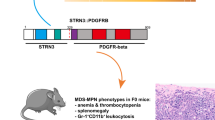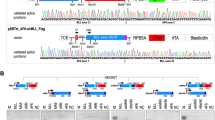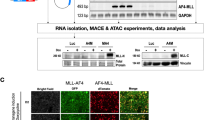Abstract
We report the cloning and characterization of the entire AFX gene which fuses to MLL in acute leukemias with a t(X;11)(q13;q23). AFX consists of two exons and encodes for a protein of 501 amino acids. We found that normal B- and T-cells contain similar levels of AFX mRNA and that both the MLL/AFX as well as the AFX/MLL fusion transcripts are present in the cell line and the ANLL sample with a t(X;11)(q13;q23). The single intron of the AFX gene consists of 3706 nucleotides. It contains five simple sequence repeats with lengths of at least 12 bps, a chi-like octamer sequence (GCA/TGGA/TGG) and several immunoglobulin heptamer-like sequences (GATAGTG) that are distributed throughout the entire AFX intron sequence. In the KARPAS 45 cell line the breakpoints occur at nucleotides 2913/2914 of the AFX intron and at nucleotides 4900/4901 of the breakpoint cluster region of the MLL gene. The AFX protein belongs to the forkhead protein family. It is highly homologous to the human FKHR protein, the gene of which is disrupted by the t(2;13)(q35;q14), a chromosome rearrangement characteristic of alveolar rhabdomyosarcomas. It is noteworthy that the t(X;11)(q13;q23) in the KARPAS 45 cell line and in one acute nonlymphoblastic leukemia (ANLL) disrupts the forkhead domain of the AFX protein exactly at the same amino acids as does the t(2;13)(q35;q14) in case of the FKHR protein. In addition, the 5′-part of the AFX protein contains a conserved hexapeptide motif (QIYEWM) that is homologous to the functionally important conserved hexapeptide QIYPWM upstream of the homeobox domain in Hox proteins. This motif mediates the co-operative DNA binding of Pbx family members and Hox proteins and, therefore, plays an important role in physiologic and oncogenic processes. In acute leukemias with a t(X;11)(q13;q23), this hexapeptide motif is separated from the remaining forkhead domain within the AFX protein. The predicted amino acid sequence of AFX differs significantly from the partial AFX protein sequence published previously (Genes, Chromosomes and Cancer, 1994, 11, 79 – 84). This discrepancy can be explained by the occurrence of two sequencing errors in the earlier work at nucleotide number 783 and 844 (loss of a cytosine residue or guanosine residue, respectively) that lead to two reading frame shifts.
This is a preview of subscription content, access via your institution
Access options
Subscribe to this journal
Receive 50 print issues and online access
$259.00 per year
only $5.18 per issue
Buy this article
- Purchase on Springer Link
- Instant access to full article PDF
Prices may be subject to local taxes which are calculated during checkout
Similar content being viewed by others
Author information
Authors and Affiliations
Rights and permissions
About this article
Cite this article
Borkhardt, A., Repp, R., Haas, O. et al. Cloning and characterization of AFX, the gene that fuses to MLL in acute leukemias with a t(X;11)(q13;q23). Oncogene 14, 195–202 (1997). https://doi.org/10.1038/sj.onc.1200814
Received:
Revised:
Accepted:
Issue Date:
DOI: https://doi.org/10.1038/sj.onc.1200814
Keywords
This article is cited by
-
Current perspective on the regulation of FOXO4 and its role in disease progression
Cellular and Molecular Life Sciences (2020)
-
Molecular analysis of more than 140 gene fusion variants and aberrant activation of EVI1 and TLX1 in hematological malignancies
Annals of Hematology (2017)
-
FOXO transcription factors in cancer development and therapy
Cellular and Molecular Life Sciences (2016)
-
Semaphorin 3A upregulates FOXO 3a-dependent MelCAM expression leading to attenuation of breast tumor growth and angiogenesis
Oncogene (2015)
-
FoxO mediates APP-induced AICD-dependent cell death
Cell Death & Disease (2014)



